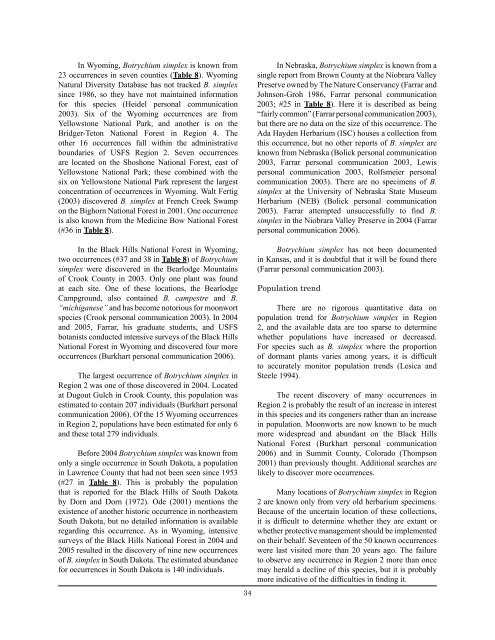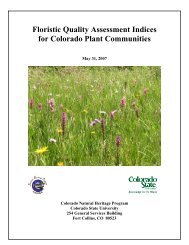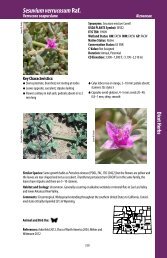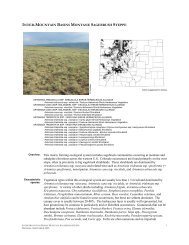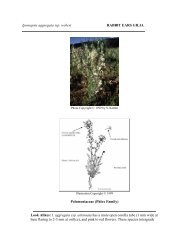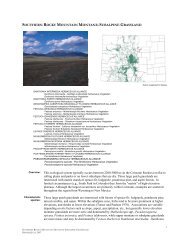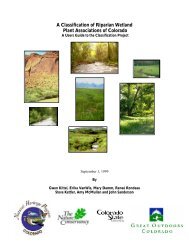Botrychium simplex E. Hitchcock (little grapefern) - Colorado Natural ...
Botrychium simplex E. Hitchcock (little grapefern) - Colorado Natural ...
Botrychium simplex E. Hitchcock (little grapefern) - Colorado Natural ...
Create successful ePaper yourself
Turn your PDF publications into a flip-book with our unique Google optimized e-Paper software.
In Wyoming, <strong>Botrychium</strong> <strong>simplex</strong> is known from<br />
23 occurrences in seven counties (Table 8). Wyoming<br />
<strong>Natural</strong> Diversity Database has not tracked B. <strong>simplex</strong><br />
since 1986, so they have not maintained information<br />
for this species (Heidel personal communication<br />
2003). Six of the Wyoming occurrences are from<br />
Yellowstone National Park, and another is on the<br />
Bridger-Teton National Forest in Region 4. The<br />
other 16 occurrences fall within the administrative<br />
boundaries of USFS Region 2. Seven occurrences<br />
are located on the Shoshone National Forest, east of<br />
Yellowstone National Park; these combined with the<br />
six on Yellowstone National Park represent the largest<br />
concentration of occurrences in Wyoming. Walt Fertig<br />
(2003) discovered B. <strong>simplex</strong> at French Creek Swamp<br />
on the Bighorn National Forest in 2001. One occurrence<br />
is also known from the Medicine Bow National Forest<br />
(#36 in Table 8).<br />
In the Black Hills National Forest in Wyoming,<br />
two occurrences (#37 and 38 in Table 8) of <strong>Botrychium</strong><br />
<strong>simplex</strong> were discovered in the Bearlodge Mountains<br />
of Crook County in 2003. Only one plant was found<br />
at each site. One of these locations, the Bearlodge<br />
Campground, also contained B. campestre and B.<br />
“michiganese” and has become notorious for moonwort<br />
species (Crook personal communication 2003). In 2004<br />
and 2005, Farrar, his graduate students, and USFS<br />
botanists conducted intensive surveys of the Black Hills<br />
National Forest in Wyoming and discovered four more<br />
occurrences (Burkhart personal communication 2006).<br />
The largest occurrence of <strong>Botrychium</strong> <strong>simplex</strong> in<br />
Region 2 was one of those discovered in 2004. Located<br />
at Dugout Gulch in Crook County, this population was<br />
estimated to contain 207 individuals (Burkhart personal<br />
communication 2006). Of the 15 Wyoming occurrences<br />
in Region 2, populations have been estimated for only 6<br />
and these total 279 individuals.<br />
Before 2004 <strong>Botrychium</strong> <strong>simplex</strong> was known from<br />
only a single occurrence in South Dakota, a population<br />
in Lawrence County that had not been seen since 1953<br />
(#27 in Table 8). This is probably the population<br />
that is reported for the Black Hills of South Dakota<br />
by Dorn and Dorn (1972). Ode (2001) mentions the<br />
existence of another historic occurrence in northeastern<br />
South Dakota, but no detailed information is available<br />
regarding this occurrence. As in Wyoming, intensive<br />
surveys of the Black Hills National Forest in 2004 and<br />
2005 resulted in the discovery of nine new occurrences<br />
of B. <strong>simplex</strong> in South Dakota. The estimated abundance<br />
for occurrences in South Dakota is 140 individuals.<br />
34<br />
In Nebraska, <strong>Botrychium</strong> <strong>simplex</strong> is known from a<br />
single report from Brown County at the Niobrara Valley<br />
Preserve owned by The Nature Conservancy (Farrar and<br />
Johnson-Groh 1986, Farrar personal communication<br />
2003; #25 in Table 8). Here it is described as being<br />
“fairly common” (Farrar personal communication 2003),<br />
but there are no data on the size of this occurrence. The<br />
Ada Hayden Herbarium (ISC) houses a collection from<br />
this occurrence, but no other reports of B. <strong>simplex</strong> are<br />
known from Nebraska (Bolick personal communication<br />
2003, Farrar personal communication 2003, Lewis<br />
personal communication 2003, Rolfsmeier personal<br />
communication 2003). There are no specimens of B.<br />
<strong>simplex</strong> at the University of Nebraska State Museum<br />
Herbarium (NEB) (Bolick personal communication<br />
2003). Farrar attempted unsuccessfully to find B.<br />
<strong>simplex</strong> in the Niobrara Valley Preserve in 2004 (Farrar<br />
personal communication 2006).<br />
<strong>Botrychium</strong> <strong>simplex</strong> has not been documented<br />
in Kansas, and it is doubtful that it will be found there<br />
(Farrar personal communication 2003).<br />
Population trend<br />
There are no rigorous quantitative data on<br />
population trend for <strong>Botrychium</strong> <strong>simplex</strong> in Region<br />
2, and the available data are too sparse to determine<br />
whether populations have increased or decreased.<br />
For species such as B. <strong>simplex</strong> where the proportion<br />
of dormant plants varies among years, it is difficult<br />
to accurately monitor population trends (Lesica and<br />
Steele 1994).<br />
The recent discovery of many occurrences in<br />
Region 2 is probably the result of an increase in interest<br />
in this species and its congeners rather than an increase<br />
in population. Moonworts are now known to be much<br />
more widespread and abundant on the Black Hills<br />
National Forest (Burkhart personal communication<br />
2006) and in Summit County, <strong>Colorado</strong> (Thompson<br />
2001) than previously thought. Additional searches are<br />
likely to discover more occurrences.<br />
Many locations of <strong>Botrychium</strong> <strong>simplex</strong> in Region<br />
2 are known only from very old herbarium specimens.<br />
Because of the uncertain location of these collections,<br />
it is difficult to determine whether they are extant or<br />
whether protective management should be implemented<br />
on their behalf. Seventeen of the 50 known occurrences<br />
were last visited more than 20 years ago. The failure<br />
to observe any occurrence in Region 2 more than once<br />
may herald a decline of this species, but it is probably<br />
more indicative of the difficulties in finding it.


